



Classic video games such as Pong, Tetris, Space Invaders, Pac Man and Super Mario have in the past decade inspired many artists in their work. The common link between all of these games is that they are very easy to learn and play. There is no need for manuals, just a few simple instructions on the screen. The graphics are simple, the colours few, the characters and style are pixelated. These games have influenced a whole generation and have over time become a part of our cultural heritage. Even today, these games still amuse and fascinate players and have also inspired various artists to use them in their art. In a series of articles, we will look at some classic games and give examples of how they have been used in art and what impact they have made on the art scene. First out is PONG.
It was the American physicist William Higinbotham who in 1958 created what many consider to be the first computer game. The game was called “Tennis for Two” and was played on an oscilloscope with help of a simple analogue control.

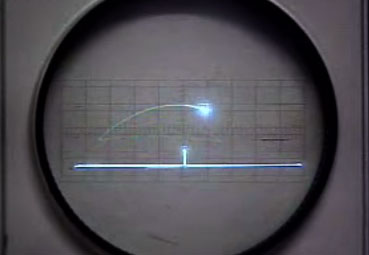
Click here to view video on Youtube…
It took, however, until 1972, when the Atari Company, founded by Allan Alcorn and Nolan Bushnell, picked up the idea and created a commercial version and called it PONG, before the game became one of the first real big sellers for the computer games industry. PONG is a simple, minimalistic game that consists of two rectangles and a square, which symbolize two tennis racquets and a ball. You can either play against another opponent or against the computer. In this simplified version of tennis, the goal is to hit the ball so the opponent misses it.
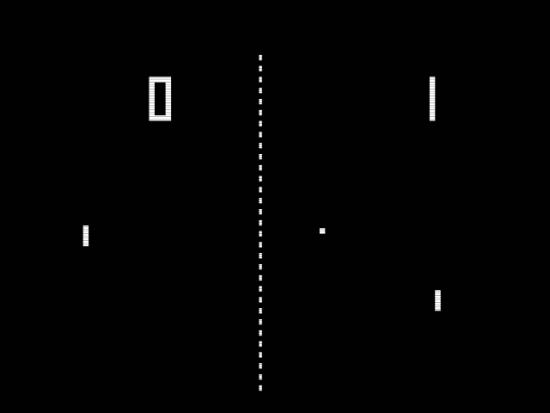
PONG is probably the videogame that has inspired most artists over the past decade. When the Computer Games Museum in Berlin in 2007 organized a major exhibition entitled “pong.mythos” over 30 artists attended with works of art inspired by PONG. The catalogue explains why PONG fascinated so many artists: “No other video game has been the origin of artistic production quite as often as the simple black-and-white tennis game. In addition to its popularity, it seems to be this minimalism that especially appeals to artists, since the playing pattern is a virtual prototype of the essence of each and every communication situation: the ball as the smallest possible unit of information, oscillating between sender and receiver” (from the catalogue “pong.mythos” 2006).
The artist group /////////fur//// showed their “Pain Station” (2001) in which the player who missed the ball were punished with physical pain, a blow on the hand, heat or an electric shock. “Pain Station” connects the physical world with the virtual and the virtual player’s mistakes turn actual real pain.
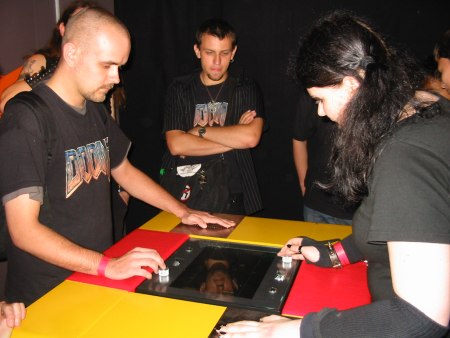
The artist group Blinkenlights working in the urban environment was represented with a project that transformed a large office building at Berlin Alexanderplatz to a digital screen where passersby could play PONG on the facade with the help of their mobile phones. In the artists S. Hanig and G. Savicic’s work “BioPong” (2005) the ball was replaced with a living cockroach where the players would try to push the insect over to the other side. And in the group Time’s Up version “Sonic Body Pong” (2006) the ball in the game was only a sound which the players could hear in their headphones and with help of large green rectangles on their heads they would try to hit the sound from the ball.
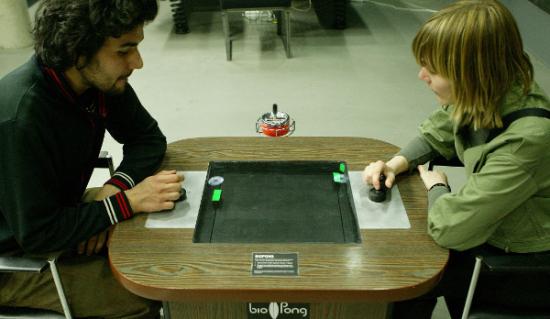
There are also many other examples that were not included in the exhibition “pong.mythos”. As early as 1999, the artist Natalie Bookchin made “The Intruder”, a work where PONG was one of 10 different videogames that she used to create an interactive artwork by Jorge Louis Borges short story “The Intruder”. The Danish artist Anders Visti mixed the game PONG with the art of Piet Mondrian in “PONGdrian v1.0” from 2007. The playing field in Vistis artwork reminiscent a painting by Mondrian but when the ball hits the fields it disturbs the lines and colour fields, and creating new opportunities and challenges for the player. Finally, I can mention the Swiss artist Guillaume Reymond, who has made a series of performances called “Game Over”. In a theatre auditorium, he creates animated sequences by using real people in colourful T-shirts, where each individual represents a square on a screen. By moving the people in the auditorium, he can create short video sequences, for example of PONG playing in the lounge.
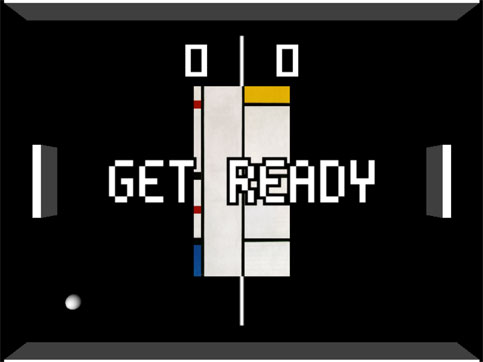
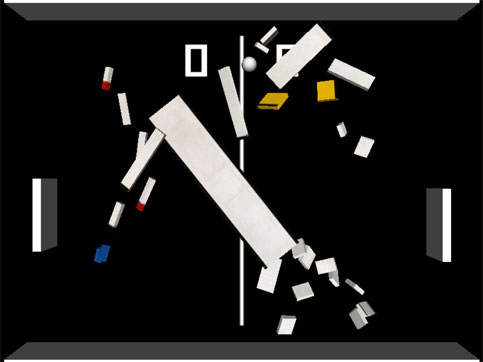
The reason that PONG is so popular among artists is that it is one of the very first video games, and therefore there is a large identification factor and a strong relationships between the game, the player and the artwork. PONG is also one of the easiest games in terms of both appearance and to learn to play, which paradoxically makes it so easy to transform and use in different contexts. The phrase “less is more” seems in this case a good explanation why PONG has inspired so many artists in recent years.
Pong Mythos – http://pong-mythos.net/index.php?lg=en
Natahalie Bookchin – The Intruder http://bookchin.net/intruder/
Guillaume Reymond – Game Over http://www.notsonoisy.com/gameover/
Anders Visti – PONGdrian v1.0 http://www.andersvisti.com/arkiv_grafik/pongdrian.html